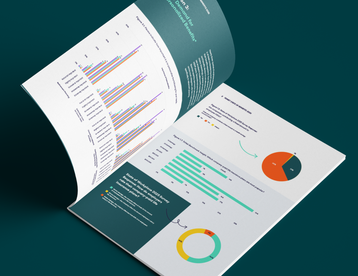Benefits as a Percent of Payroll: Small Business Benchmarking Insight

Running a small or medium-sized business (SMB) means making dozens of decisions every week that can directly affect your people and your bottom line. Few decisions, however, carry as much long-term weight as how you design and fund your employee benefits program. The right mix of health insurance, retirement contributions, and paid leave can help you attract top talent, enhance retention, and strengthen culture. But spend too much—or too little—and you may risk destabilizing budgets or losing out in the war for talent.
That’s where benchmarking comes in. By comparing your benefits spending against national and industry averages, you can get a general sense whether your investments are in line, identify possible opportunities for improvement, and take a strategic approach to total rewards.
Our new Benefits as a Percent of Payroll Worksheet helps take the guesswork out of this process, helping small business leaders quickly estimate how they may stack up against peers and answer “How much should a small business spend on benefits as a percent of payroll?” In this article, we’ll walk through how to use the worksheet, what the benchmarks mean, and insights to consider to optimize your benefits strategy.
The Must-Have Health Insurance and Benefits Readiness Checklist
For small businesses, managing employee benefits can feel like a daunting task. Our checklist helps streamline the process, giving you clarity on what resources you may need to help balance costs, navigate compliance and understand employee needs. Sidestep common challenges and stay on track.
Step 1: Calculate Your Benefits Ratio
The first step in making strategic benefit decisions is getting clear on your current small business benefit costs. The worksheet outlines three key calculations:
- Calculate your total benefits cost.Add up all employer-paid benefits for the year: health insurance premiums, retirement contributions, paid leave (vacation, sick days, holidays), and any other programs like life insurance, disability coverage, or wellness stipends.
- Calculate payroll.Use the total gross wages, along with any additional pay such as bonuses or commissions, paid to employees over the same period. Exclude employer-paid benefits to avoid double counting.
- Compute your benefits ratio.Divide your total benefits cost by your payroll, then multiply by 100 to get a percentage. This gives you a snapshot of how much of your compensation budget is going toward benefits.
This ratio becomes the foundation for all your employee benefits benchmarking.
Step 2: Compare Against National Benchmarks
Knowing your number is one thing; understanding what it means is another. According to the U.S. Bureau of Labor Statistics (2025), average percentage of benefits represent:
- 29.7% of total compensation for private industry workers
- 38.4% for government workers
- 31.3% for the civilian average (all workers combined)

Did you know: Mental health coverage ranks as the #1 most important benefit across all generations?
Read more and discover other stats in The State of Employee Benefits.
If your employer benefits ratio falls within 30–40% of payroll, you’re generally aligned with most employers. A ratio above 40% could mean you’re potentially overspending compared to benchmark, while anything below 30% might signal under-investment. Both situations may affect your competitiveness in attracting and retaining talent.
Step 3: Industry Benchmarks for Benefits Spending
Every industry operates differently, and so do their benefit structures. For example, healthcare and financial services may carry higher benefit costs per employee, while industries like construction or retail tend to fall lower on the scale. It’s important to know the average benefits cost per employee by industry to build an effective benchmark for your small business.
Here are the average annual employer benefit costs per employee, based on 2025 data*:
- Government / Education / Utilities: $14,102
- Financial / Insurance / Real Estate: $13,603
- Professional / Scientific / Technology: $13,770
- Health Care / Social Assistance: $14,674
- Manufacturing: $15,246
- Wholesale / Retail: $11,906
- Construction / Agriculture / Transportation: $13,046
- Information / Arts / Accommodation & Food: $13,250
By plugging in your own average (total benefits ÷ number of employees), you can see how you may compare to others in your industry. This can help small businesses answer the crucial question, “how do I know if I’m potentially overspending or under-investing in benefits?”.
Step 4: Interpret Results for Small Business HR
Once you’ve benchmarked your numbers, it’s time to interpret what it may mean. Here’s a simple framework to help:
- ✅ Within 30–40% of payroll: You’re in line with most employers. This is likely in the “safe zone” where your benefits program is in a generally comfortable range.
- ⚠️ Above 40%: You may be overspending. This could be a sign that there may be opportunities to revisit your plan design, cost-sharing approach, or carrier relationships.
- ⚠️ Below 30%: You may be under-investing in your employees, so there may be opportunities to invest more, which could help support recruitment, retention, and morale.
It’s also important to consider other factors:
- Company size matters. Smaller businesses often pay more per employee because they lack the buying power of larger organizations.
- Industry matters. If your field is known for richer benefits, cutting corners can leave you at a competitive disadvantage.
- Talent strategy matters. Sometimes, going above the benchmark makes sense if benefits are a key differentiator in hiring and retention.
Step 5: Build a Benefits Action Plan
The real value of benchmarking comes when you use it to spark action. The worksheet includes space for you to note key observations, outline opportunities to adjust, and capture questions for your broker or advisor. Some practical steps include:
- Revisiting plan design. If costs are too high, explore options like voluntary benefits, or adjusting employer vs. employee contributions.
- Rebalancing total rewards. Maybe your employee benefits spend is low, but you offer strong career development or culture perks. A balanced approach is often more sustainable than over-investing in one area.
- Engaging advisors. A trusted benefits broker or PEO can help you model contribution strategies and provide insights tailored to your industry and workforce size.
- Communicating with employees. Even the best benefits lose impact if employees don’t understand or appreciate them. Regularly educate your employees on the full value of their package.
Why this matters now
Employee expectations around benefits have shifted dramatically in recent years. Flexibility, well-being, and financial security are now top priorities, alongside traditional health and retirement benefits. In today’s competitive labor market, small businesses that align benefits with employee needs—while keeping costs in check—are generally in a better position to thrive.
Data from our State of Small Business Employee Benefits campaign shows that benefits are not just a cost center but a critical investment in talent strategy. Employees who feel supported by their benefits are more engaged, more loyal, and more likely to see their employer as a long-term partner in their careers.
For small business leaders, the message is clear: benchmarking isn’t optional—it’s important.
Putting it all together
The Benefits as a Percent of Payroll Worksheet offers SMBs a straightforward, high-level view of their benefits spending, along with benchmarks to help with potential next steps. Here’s how it all comes together:
- Calculate your benefits ratio. Get a number that represents your spend as a percentage of payroll.
- Benchmark nationally and by industry. See how you stack up against benchmark national and industry averages.
- Interpret your results. Identify whether you’re in line, overspending, or under-investing.
- Build an action plan. Use insights to optimize costs, strengthen competitiveness, and align benefits with talent strategy.
Ultimately, benchmarking is a starting point—not the finish line. The goal isn’t to match numbers perfectly, but to use them as a springboard for strategic decisions. With relevant insights, small business leaders can turn benefits from a cost challenge into a competitive advantage, helping to reduce the potential risks of under-investing in employee benefits.
Final thoughts
Small business leaders wear many hats: strategist, operator, recruiter, and financial steward. Navigating the complex world of benefits can feel overwhelming, but insights like the Benefits as a Percent of Payroll Worksheet can help provide clarity.
By measuring, comparing, and interpreting your benefits spend, you gain the insights needed to align costs with employee expectations—helping your business in staying competitive and financially balanced.
In the end, offering benefits isn’t just about compliance or keeping up with peers. It’s about sending a message to your employees: We value you, we’re invested in your well-being, and we want you to thrive with us.
That message, backed by thoughtful strategy and clear benchmarks, can be one of the strongest assets in your small business’ growth journey.
FAQs
What percentage of payroll should go to employee benefits?
Most small businesses spend between 30% and 40% of payroll on employee benefits. Staying within this range helps you stay generally aligned with national benchmarks while supporting competitiveness for talent. Spending below 30% may signal under-investment, while above 40% may indicate overspending.
How do I calculate benefits as a percent of payroll?
To calculate:
- Add up all employer-paid benefits (health insurance, retirement, paid leave, etc.).
- Divide that number by your total payroll.
- Multiply by 100 to get your percentage.
How do benefit costs vary by industry?
Industries differ widely:
- Financial & Insurance: ~$13,142 per employee annually
- Healthcare & Social Assistance: ~$13,935
- Manufacturing: ~$12,598
- Construction/Transportation: ~$11,699These averages help small businesses compare their benefits spend to peers.
What’s included in employee benefit costs?
Employee benefits typically include:
- Health, dental, and vision insurance
- Retirement contributions (401(k), SIMPLE IRA)
- Paid leave (vacation, holidays, sick days)
- Life insurance, disability insurance, and wellness benefits
How can small businesses optimize benefit costs while maintaining strong retention?
Practical insights include:
- Offering tiered health plans or voluntary benefits
- Adjusting employer vs. employee contribution levels
- Working with a PEO to get access to premium benefits
- Communicating benefits value so employees fully understand their package
*Notes on ECEC calculations:
- Source: BLS ECEC, March 2025 release.
- Used “Total benefits” column in Tables 2–4.
- Multiplied cost per hour × 2,080 (40 hrs/week × 52 weeks).
- For broad groupings (e.g., “Wholesale/Retail,” “Construction/Agriculture/Transportation,” “Info/Arts & Food”), industry subcategories were combined.
- Rounded to nearest whole dollar.
The calculation worksheet is for informational purposes only and does not constitute financial, tax, legal, or HR advice. These figures represent general averages and are based primarily on publicly available online data. Actual numbers may vary based on many factors such as employer contributions, plan design and costs, employee demographics, location, tax laws, and pay. Consult your advisors before making decisions. Use of this article does not create any relationship between you and us, and we are not responsible for any actions taken based on its content.
This article is for informational purposes only, is not legal, tax or accounting advice, and is not an offer to sell, buy or procure insurance. It may contain links to third-party sites or information for reference only. Inclusion does not imply TriNet’s endorsement of or responsibility for third-party content.
Table of contents
- 1.Step 1: Calculate Your Benefits Ratio
- 2. Step 2: Compare Against National Benchmarks
- 3. Step 3: Industry Benchmarks for Benefits Spending
- 4.Step 4: Interpret Results for Small Business HR
- 5. Step 5: Build a Benefits Action Plan
- 6.Why this matters now
- 7.Putting it all together
- 8.Final thoughts
- 9.FAQs
- 10.What percentage of payroll should go to employee benefits?
- 11.How do I calculate benefits as a percent of payroll?
- 12.How do benefit costs vary by industry?
- 13.What’s included in employee benefit costs?
- 14.How can small businesses optimize benefit costs while maintaining strong retention?






